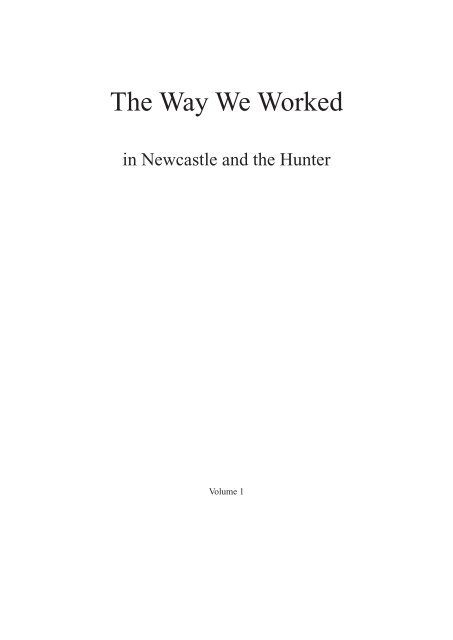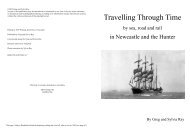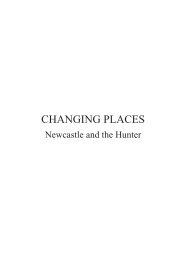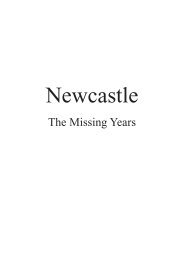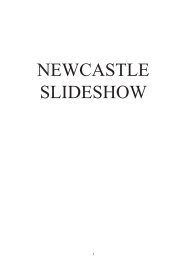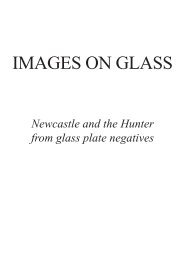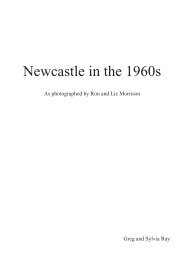the way we worked
You also want an ePaper? Increase the reach of your titles
YUMPU automatically turns print PDFs into web optimized ePapers that Google loves.
The Way We Worked<br />
in Newcastle and <strong>the</strong> Hunter<br />
Volume 1
©2016 Greg and Sylvia Ray<br />
No part of this publication may be reproduced or transmitted in any form or by any means electronic<br />
or mechanical, and including photocopying, recording or by information storage and retrieval systems,<br />
without <strong>the</strong> written permission of <strong>the</strong> copyright owner.<br />
Printed by NCP Printing, Steel River, Newcastle<br />
Published by Greg and Sylvia Ray<br />
Concept and design by Greg and Sylvia Ray<br />
ISBN 978-0-9871883-6-6<br />
Front cover photo: A construction worker at Kurri Kurri’s Alcan aluminium smelter in 1968.<br />
Title page vignette: A young worker at BHP’s Newcastle steelworks in 1962.
The Way We Worked<br />
in Newcastle and <strong>the</strong> Hunter<br />
Volume 1<br />
By Greg and Sylvia Ray
The ever-changing face of work<br />
For <strong>the</strong> first tens of thousands of years of human habitation in <strong>the</strong> valley of <strong>the</strong> river <strong>we</strong> now call <strong>the</strong><br />
Hunter, work meant <strong>the</strong> direct day-to-day business of extracting food, shelter and o<strong>the</strong>r requirements from<br />
<strong>the</strong> natural environment.<br />
But when <strong>the</strong> British Empire claimed <strong>the</strong> continent of Australia and put it to use for <strong>the</strong> exiling of<br />
unwanted prisoners and political malcontents, convicts <strong>we</strong>re soon put to work at <strong>the</strong> Coal River extracting<br />
<strong>the</strong> fossil fuel that po<strong>we</strong>red <strong>the</strong> industrial revolution, as <strong>we</strong>ll as cedar and lime to help build Sydney. A new<br />
world of work, in which labour was a commodity to be traded or coerced, had arrived on Australian soil.<br />
Newcastle began as a secondary prison-within-a-prison for <strong>the</strong> colony’s most troublesome convicts. When<br />
<strong>the</strong> Hunter district’s isolation was broken by <strong>the</strong> discovery of overland routes from Sydney, farming moved<br />
in and turned <strong>the</strong> region into Sydney’s food-bowl, with Maitland as its prosperous centre.<br />
Next, large-scale private exploitation of <strong>the</strong> vast coal reserves beneath Newcastle created what many called<br />
a “Coalopolis” and, over <strong>the</strong> decades to come, industries of many kinds <strong>we</strong>re drawn to <strong>the</strong> mouth of <strong>the</strong><br />
Hunter River by <strong>the</strong> lure of cheap energy and abundant willing workers.<br />
World wars came and <strong>we</strong>nt. Industries sprouted, blossomed and died.<br />
In <strong>the</strong> 21st century Newcastle is a post-industrial city, and <strong>the</strong> Hunter might be described as a postagricultural<br />
valley, with massive-scale open-cut coalmining – mostly for <strong>the</strong> export market – one of <strong>the</strong> most<br />
visible players in <strong>the</strong> regional economy. But mining isn’t labour-intensive anymore, and <strong>the</strong> transnational<br />
corporations that dominate <strong>the</strong> sector are constantly seeking <strong>way</strong>s to make it even more capital-intensive.<br />
The really big employers, <strong>the</strong>se days, are in <strong>the</strong> service sectors.<br />
Manufacturing, a dominant sector in <strong>the</strong> Hunter in <strong>the</strong> second half of <strong>the</strong> 20th century, has suffered a<br />
spectacular decline as “globalisation” – <strong>the</strong> movement of capital investment in industrial production to<br />
countries with lo<strong>we</strong>r wages and environmental standards – has become <strong>the</strong> dominant force in economic and<br />
political life. Anybody observing Newcastle in <strong>the</strong> years from 1980 to 2000 would have seen industry after<br />
industry and factory after factory shutting down, displacing thousands of workers and rendering hard-won<br />
skills obsolete or unmarketable.<br />
This trend in <strong>the</strong> private sphere was accompanied in <strong>the</strong> public sector by increasing centralisation, typified<br />
by <strong>the</strong> withdrawal of local jobs, services and decision-making autonomy back to <strong>the</strong> state capital. Trade<br />
union po<strong>we</strong>r declined massively. The once influential Newcastle Trades Hall Council has declined in po<strong>we</strong>r<br />
and <strong>the</strong> mining union that could once stop <strong>the</strong> valley wields far less clout than in past years.<br />
From a personal perspective my experience may be typical. My paternal grandfa<strong>the</strong>r <strong>worked</strong> in various<br />
jobs around Newcastle, including as a coalminer and as a foreman with <strong>the</strong> Hunter District Water Board.<br />
My grandfa<strong>the</strong>r on my mo<strong>the</strong>r’s side <strong>worked</strong> at <strong>the</strong> BHP steelworks until he was injured at work and “let<br />
go” to find alternative employment outside <strong>the</strong> city as a rail<strong>way</strong> ganger. Both my grandmo<strong>the</strong>rs <strong>we</strong>re fully<br />
employed on “home duties” for most of <strong>the</strong>ir adult lives, though my maternal grandmo<strong>the</strong>r did some paid<br />
cleaning work to supplement <strong>the</strong> family income.<br />
My mo<strong>the</strong>r had some clerical jobs but marriage and childbirth intervened and, during much of her time as<br />
a potential member of <strong>the</strong> labour force married mo<strong>the</strong>rs <strong>we</strong>re not encouraged to seek paid work.<br />
My fa<strong>the</strong>r trained as a fitter and turner in <strong>the</strong> years when <strong>the</strong> metal trades <strong>we</strong>re ubiquitous in Newcastle,<br />
seizing <strong>the</strong> opportunity to switch to <strong>the</strong> drawing office and moving from Stewarts and Lloyds to <strong>the</strong><br />
Sulphide Corporation, which offered generous inducements for skilled employees and opportunities for his<br />
advancement into senior plant engineering roles.<br />
I recall being told while still at high school that I should prepare myself for a career in one of <strong>the</strong> big<br />
secondary industries – <strong>the</strong> BHP steelworks was highly recommended – and although I didn’t follow that<br />
advice I never suspected that <strong>the</strong> great steel plant’s days <strong>we</strong>re so nearly numbered as time proved <strong>the</strong>m to be.<br />
But few jobs are safe from change. My 30-year career in journalism was notable for <strong>the</strong> knowledge I had<br />
from my first day that newspaper circulation was declining. As time passed, massive changes <strong>we</strong>re adopted<br />
by media companies seeking to cut costs and maintain profits. Printers <strong>we</strong>re laid off wholesale and computer<br />
technology was embraced. Offshoring came. Formats changed. Content was trimmed. The onslaught of<br />
competing technologies – culminating in <strong>the</strong> internet – was an irresistible tide.<br />
What jobs or careers my three children may choose is unclear to me. Work is still changing.
This book, our seventh, is a celebration of work in <strong>the</strong> Hunter and its ever-evolving nature.<br />
We hope it will prove entertaining and informative to some readers, and that it will be a source of pleasant<br />
memories for those who spent some of <strong>the</strong>ir own working days in <strong>the</strong> industries and with <strong>the</strong> companies<br />
illustrated and described.<br />
As usual <strong>we</strong> have many people to thank for <strong>the</strong>ir help and kindness in assembling this collection of images<br />
and anecdotes. Jorg Griep, whose fa<strong>the</strong>r Horst took many photographs that appear in <strong>the</strong> book, was kind<br />
enough to make available a substantial collection of prints and negatives.<br />
Ron and Liz Morrison – our mentors in some <strong>way</strong>s – have also been exceptionally generous in permitting<br />
us to use some of <strong>the</strong>ir marvellous images. Norman and Betty Mead also shared information and photos.<br />
Ron Bell, a former colleague at The Newcastle Herald, provided still more negatives.<br />
We must acknowledge <strong>the</strong> enduring legacy of <strong>the</strong> late Ken Magor, whose collections started us on our<br />
publishing path in 2010, and of <strong>the</strong> families of <strong>the</strong> late Milton Merrilees and Arch Miller – both Herald<br />
photographers – who have helped us repeatedly. The same is true of Daphne Barney, wife of my late former<br />
Herald colleague Norm, whose unfailing support has been of immense value. Yvonne Austin, niece of <strong>the</strong><br />
late Douglass Baglin, has been very kind in letting us use some of her uncle’s wonderful work.<br />
Thanks too, to Brian Andrews, for helping me with details of coal industry history.<br />
Many o<strong>the</strong>r contributors deserve thanks, and some of <strong>the</strong>ir names will be found in <strong>the</strong> acknowledgement<br />
column at <strong>the</strong> end of <strong>the</strong> book. To my regret I have mislaid <strong>the</strong> details of some helpers, and can only say that<br />
I am sincerely sorry and will try to make up for my carelessness in any <strong>way</strong> I can.<br />
As al<strong>way</strong>s I thank my wife Sylvia for her skill and patience in making <strong>the</strong>se images as fit for printing and<br />
publication as can be, and for helping me make <strong>the</strong> transition in this past year from paid employment to selfemployment.<br />
Again, <strong>the</strong> changing nature of work . . .<br />
We intend this book to be <strong>the</strong> first in a series following <strong>the</strong> same <strong>the</strong>me, and encourage people with<br />
interesting pictures and stories about jobs and work in <strong>the</strong> Hunter to contact us at <strong>the</strong> email address in <strong>the</strong><br />
back of <strong>the</strong> volume.<br />
Greg Ray<br />
BHP steelworks was <strong>the</strong> definitive face of work in Newcastle for many decades.
The <strong>way</strong> <strong>we</strong> <strong>worked</strong>, for thousands of years<br />
The Hunter Region has been inhabited by human beings for tens of thousands of years, in which <strong>the</strong> most<br />
recent two centuries is a mere blink of an eye. For residents of <strong>the</strong> Hunter, <strong>the</strong> lifestyles of our Aboriginal<br />
forebears is of <strong>the</strong> greatest interest. These ancient people had a highly organised society based on a close<br />
relationship with <strong>the</strong> land and sea that provided all <strong>the</strong>ir needs for generations beyond telling.<br />
In such a society <strong>the</strong> concept of work could not help but differ greatly from <strong>the</strong> model imported by white<br />
convicts and settlers. European colonists brought <strong>the</strong> seeds of industrial economics and <strong>the</strong> principles of<br />
individual ownership of land and livestock – ideas that seemed alien and absurd to indigenous people whose<br />
lives <strong>we</strong>re organised around extended family, clan and tribal centres.<br />
Sadly little is reliably known about <strong>the</strong> long-term occupants of <strong>the</strong> country now known as <strong>the</strong> Hunter<br />
Valley. Many of <strong>the</strong>ir words survive in place names – albeit twisted and garbled to suit tongues accustomed<br />
to different sounds. And some contemporaneous accounts of <strong>the</strong> earlier people exist in writing, offering<br />
tantalising glimpses of a romantic and fascinating past where seemingly simple technologies had evolved to<br />
exceptionally high standards and where <strong>the</strong> everyday skills applied to <strong>the</strong> challenges of living would amaze<br />
and baffle most inhabitants of modern cities and towns.<br />
Food, water, shelter, entertainment, defence, clothing and adornment, trade and transport are common<br />
human wants, and <strong>the</strong> efforts involved in satisfying <strong>the</strong>se wants are what <strong>we</strong> call “work”. In a superspecialised<br />
society like <strong>the</strong> dominant 21st century industrial model, work shifts with changing fashions and<br />
technologies and, most of all, with global flows of money that constantly seeks <strong>the</strong> lo<strong>we</strong>st-priced inputs to<br />
ensure <strong>the</strong> highest possible profits from <strong>the</strong> sale of goods and services. Skills acquired over a lifetime of<br />
work can be rendered redundant almost overnight.<br />
In hunter-ga<strong>the</strong>rer societies, work skills refined by generations of trial and error could be acquired to a<br />
greater or lesser extent by every member of <strong>the</strong> community and <strong>the</strong>se skills <strong>we</strong>re passed from hand to hand<br />
and mouth to mouth over immeasurable periods of time.<br />
When <strong>the</strong> United States Exploring Expedition visited NSW in 1839, its observers remarked that:<br />
“The natives of New South Wales are a proud, high-tempered race: each man is independent of his<br />
neighbour, owning no superior, and exacting no deference; <strong>the</strong>y have not in <strong>the</strong>ir language any word<br />
signifying a chief or superior, nor to command or serve. Each individual is <strong>the</strong> source of his own comforts,<br />
and <strong>the</strong> artificer of his own household implements and <strong>we</strong>apons; and but for <strong>the</strong> love of companionship, he<br />
might live with his family apart and isolated from <strong>the</strong> rest, without sacrificing any advantages whatever.”<br />
Food was plentiful. Birds and animals filled <strong>the</strong> forests that grew around <strong>the</strong> rivers and swampy lowlands.<br />
Fish, molluscs and crustaceans teemed in <strong>the</strong> ocean and inland water<strong>way</strong>s.<br />
There was a big mutton bird colony on an island at <strong>the</strong> mouth of Lake Macquarie which was raided for<br />
eggs and chicks once a year, but protected with stringent laws at o<strong>the</strong>r times.<br />
Women fished with lines and nets and ga<strong>the</strong>red such vegetable staples as bracken fern roots (which <strong>we</strong>re<br />
roasted and pounded), <strong>the</strong> young stalks of <strong>the</strong> gigantic lily (soaked and roasted), nuts from <strong>the</strong> burrawong (a<br />
cycad, <strong>the</strong> nut of which had to be soaked for some time to remove toxins), wild plums and yam-like tubers<br />
of various kinds.<br />
The diary of Lieutenant William Sacheverall Coke, who was stationed at Newcastle in 1827, described <strong>the</strong><br />
abundance of seafood:<br />
“We can catch here eight or nine large fish called snapper in an hour – numbers of salmon, mullet – and <strong>we</strong><br />
are obliged to kill four or five sharks <strong>the</strong>re are so many here”. He wrote that <strong>the</strong> blacks swam to <strong>the</strong> seabed<br />
and returned with lobsters four times larger than those in England.<br />
1
Coke made sailing excursions to Ash Island, in <strong>the</strong> stream of <strong>the</strong> Hunter River, shooting wood pigeons that<br />
<strong>we</strong>ighed as much as kilogram. He reported seeing a herd of kangaroos, some black swans and thousands of<br />
ducks. In <strong>the</strong> Myall River he saw hundreds of pelicans and “wild ducks that almost covered <strong>the</strong> water”.<br />
At Port Stephens, women made fishing lines from <strong>the</strong> inner bark of young kurrajong trees. The bark was<br />
stripped and soaked in water until <strong>the</strong> outer portion could be scraped off with a shell, leaving a tough, flaxlike<br />
fibre. “The women twisted this fibre to <strong>the</strong> required length and thickness by rolling it on <strong>the</strong> front part of<br />
<strong>the</strong> thigh with <strong>the</strong> hands”. William Scott, son of an employee of <strong>the</strong> Australian Agricultural Company at Port<br />
Stephens, wrote that <strong>the</strong>se lines <strong>we</strong>re extraordinarily strong and capable of landing <strong>the</strong> heaviest fish. Hooks<br />
<strong>we</strong>re made from shell or bone.<br />
Bark canoes, made from a single flawless sheet of stringybark, <strong>we</strong>re used to criss-cross Port Stephens,<br />
Lake Macquarie and o<strong>the</strong>r water<strong>way</strong>s in <strong>the</strong> region. These al<strong>way</strong>s had a characteristic clay mound, often in<br />
<strong>the</strong> stern, where a small fire was kept burning while <strong>the</strong> canoes <strong>we</strong>re in use. Christian missionary Lancelot<br />
Threlkeld wrote that “it was a pleasing sight on a summer’s evening to see a number of <strong>the</strong> native canoes<br />
on <strong>the</strong> glasslike surface of <strong>the</strong> lake, sending up <strong>the</strong>ir strait columns of smoke from <strong>the</strong> centre of <strong>the</strong> barques,<br />
shewing an appearance of a fleet of small steamers at anchor in <strong>the</strong> stream. . . . The wild vines of <strong>the</strong> bush<br />
formed <strong>the</strong>ir cables and a heavy stone was <strong>the</strong> substitute for an anchor,” he wrote.<br />
The skill of <strong>the</strong> Aborigines with hunting spears was legendary. Early European settlers reported that <strong>the</strong><br />
spears <strong>we</strong>re very accurate up to 100m. Scott wrote that “with a woomera to aid <strong>the</strong> case, <strong>the</strong>y could hit a<br />
mark at almost every throw up to a distance of 50 to 75 yards”. The po<strong>we</strong>r and accuracy of <strong>the</strong> spear was<br />
enhanced by <strong>the</strong> use of a woomera, which acted as an extension of <strong>the</strong> thro<strong>we</strong>r’s arm. Observers commented<br />
on <strong>the</strong> amazing workmanship used in producing tools and <strong>we</strong>apons.<br />
Two sketches by artist Alfred<br />
Agate, who accompanied <strong>the</strong> US<br />
Exploring Expedition to NSW<br />
in 1839. At left is “Shingleman”<br />
of Lake Macquarie. At right is<br />
“Bamboo Cain” of Newcastle.<br />
Threlkeld wrote that <strong>the</strong> spears, mostly just over 2m long, <strong>we</strong>re often made in three parts, two being of<br />
grass tree stem and one of hardwood.<br />
“The ends of <strong>the</strong> grass tree are charred in <strong>the</strong> fire, fitted one into <strong>the</strong> o<strong>the</strong>r with <strong>the</strong> melted rosin infused,<br />
<strong>the</strong> joint is tied with a filament of bark, and a lump of gum wrapped around <strong>the</strong> joint, having <strong>the</strong> appearance<br />
of a ball of cobbler’s wax,” he wrote. “It is roasted over <strong>the</strong> fire and as it is softened by <strong>the</strong> heat, <strong>the</strong> gum is<br />
put into shape by <strong>the</strong> <strong>we</strong>tted fingers of <strong>the</strong> artisan.”<br />
The point was of fire-hardened hardwood, with perhaps some bone barbs. These spears <strong>we</strong>re mainly<br />
made on <strong>the</strong> coast and <strong>we</strong>re very popular as a trading item with inland tribes, who swapped such goods as<br />
decorated cloaks of kangaroo and possum skin and hand-spun ropes of possum-hide.<br />
Despite <strong>the</strong> fact that <strong>the</strong>y had few musical instruments (<strong>the</strong> didgeridoo was not used in NSW), <strong>the</strong> Hunter’s<br />
Aborigines <strong>we</strong>re a very musical people. They loved music and poetry and, as <strong>we</strong>ll as <strong>the</strong>ir acknowledged<br />
and sometimes sacred classics, <strong>the</strong>y had an ever-changing hit parade of new songs which <strong>we</strong>re shared from<br />
tribe to tribe as soon as <strong>the</strong>y <strong>we</strong>re written. People gifted in poetry, song and dance <strong>we</strong>re widely acclaimed<br />
and prized as star attractions at <strong>the</strong> highly social corroborees.<br />
According to Threlkeld, <strong>the</strong>re was an old man named Wullati who lived close to Moon Island, at <strong>the</strong> mouth<br />
of Lake Macquarie, and was famous for many miles around as a great poet, singer and performer.<br />
“He was very old, thin, small-headed and of a most cheerful disposition. Whenever he came to our tribe,<br />
his company was much enjoyed, an evening feast was provided and <strong>the</strong> choicest titbits <strong>we</strong>re set before <strong>the</strong><br />
toothless guest.” Wullati was a humorist and Threlkeld wrote that his stories and repartee would greatly<br />
amuse <strong>the</strong> revellers until, after <strong>the</strong> feast, he sang and danced to <strong>the</strong> musical accompaniment of two sticks.<br />
“The poets often make a song extempore, and if it happens to suit <strong>the</strong> humour of <strong>the</strong> tribe, its popularity is<br />
stamped . . . and messengers would be despatched from tribe to tribe to teach <strong>the</strong> melody to o<strong>the</strong>rs who in<br />
turn convey <strong>the</strong> new song set to music, without variation, to <strong>the</strong> most distant tribes in NSW.”<br />
2
The town and harbour of Newcastle, as depicted in an engraving in The Illustrated Sydney News of March 16,<br />
1865. The accompanying article states that: “T<strong>we</strong>nty years ago Newcastle was an insignificant village, with<br />
but a single coal mine – that of <strong>the</strong> AA Company which, enjoying a monopoly, was content with raising 25,000<br />
tons during <strong>the</strong> year”. By 1865 that lone mine had been joined by Waratah, Wallsend, Lambton, Minmi and<br />
o<strong>the</strong>rs, with rail lines to <strong>the</strong> port where four steam cranes loaded hundreds of vessels with cargoes of coal.<br />
An engraving of <strong>the</strong> Newcastle area, with St Johns Church, Cooks Hill, from The Illustrated Sydney News of<br />
August 16, 1865. The paper described <strong>the</strong> coal deposits of <strong>the</strong> Newcastle area as “of almost unlimited extent”.<br />
3
Chasing coal, from Newcastle to <strong>the</strong> valley<br />
It is hard to imagine what <strong>the</strong> Hunter Valley, and <strong>the</strong> harbour at <strong>the</strong> mouth of its namesake river, might<br />
have been like if it had not been for coal. The discovery of coal at <strong>the</strong> river north of <strong>the</strong> infant settlement of<br />
Sydney in <strong>the</strong> latter years of <strong>the</strong> 18th century prompted almost immediate efforts to extract it, and it wasn’t<br />
long before colonial governors started sending convicts north to work makeshift mines.<br />
In time <strong>the</strong> convict-operated mines gave <strong>way</strong> to <strong>the</strong> commercial operations of <strong>the</strong> Australian Agricultural<br />
Company, and soon that state-sponsored monopoly was forced to give <strong>way</strong> to numerous mining<br />
entrepreneurs. As mines spread out from what became <strong>the</strong> city of Newcastle, <strong>the</strong> shape of future suburbs was<br />
mapped, with houses, roads and rail and tram lines springing up to follow <strong>the</strong> coal and serve <strong>the</strong> miners.<br />
Australia’s first export was coal from Newcastle and, over <strong>the</strong> decades as <strong>the</strong> mines shifted inland and<br />
technology changed, <strong>the</strong> volumes of coal shipped through <strong>the</strong> port climbed to levels that <strong>the</strong> early pioneers<br />
could never have imagined possible.<br />
In <strong>the</strong> 21st century massive-scale open-cut mining has become <strong>the</strong> norm, and <strong>the</strong> industry has shifted<br />
from <strong>the</strong> labour-intensive pattern of <strong>the</strong> past to an increasingly capital-intensive and export-oriented model.<br />
Not long ago it was calculated that, if all <strong>the</strong> coal extracted from <strong>the</strong> Hunter in <strong>the</strong> 10 preceding years was<br />
stacked in a column one metre square, <strong>the</strong> column would reach to <strong>the</strong> moon and back, with plenty left over.<br />
While <strong>the</strong> days of <strong>the</strong> old underground pits, with <strong>the</strong>ir attendant armies of men and horses, are long gone,<br />
<strong>the</strong> legacy remains all around. The district is extensively undermined at many levels, with shafts and tunnels<br />
underlying <strong>the</strong> city and suburbs in a bewildering spider <strong>we</strong>b that no maps can illustrate with complete<br />
accuracy.<br />
Mining has changed or erased watercourses, altered landforms, changed <strong>the</strong> shoreline of Lake Macquarie<br />
and removed or altered forever some villages in <strong>the</strong> Hunter Valley.<br />
While modern mining is often characterised as “quarrying”, <strong>the</strong> practices of <strong>the</strong> past gave birth to<br />
many tasks and skills now rapidly being forgotten. Men now alive can recall with clarity <strong>the</strong> dangers and<br />
challenges of working deep underground, with po<strong>we</strong>r supplied by horses and with no more than timber<br />
props holding up <strong>the</strong> roofs and <strong>the</strong> threats from fire, gas and collapses an ever-present concern.<br />
A delightfully atmospheric early morning portrait of a group of wheelers and pit horses at Pelaw Main colliery.<br />
4
Mines and miners of <strong>the</strong> old days: Photograph above, by Ralph Snowball, shows Greta colliery in about 1902.<br />
Below: ano<strong>the</strong>r Snowball portrait of mining union delegates and officials at Lambton Colliery on May 27, 1897.<br />
5
Ralph Snowball photograph of miners near <strong>the</strong> train used to carry workers at Burwood Colliery, circa 1898.<br />
Below is ano<strong>the</strong>r typical Snowball portrait of pit top workers, probably at West Wallsend colliery, circa 1900.<br />
6
Horst Griep, above, <strong>worked</strong> in <strong>the</strong> Agfa factory in Germany before World War II and came to Australia after<br />
<strong>the</strong> war. After a short time at Greta migrant camp he <strong>we</strong>nt to work at <strong>the</strong> BHP steelworks where his skills <strong>we</strong>re<br />
noted by management and put to good use. His photo below shows <strong>the</strong> works from across <strong>the</strong> river in 1960.<br />
65
Above: BHP’s basic oxygen plant in 1962. The photograph below shows a worker in <strong>the</strong> rod mill in 1960.<br />
66
Above: A view across Newcastle’s steelworks in 1959. Below: Construction of <strong>the</strong> basic oxygen plant in 1962.<br />
67
A superb Horst Griep photograph showing construction of <strong>the</strong> No. 4 blast furnace at BHP Newcastle in 1963.<br />
68
69
These fine press photographs of various parts of <strong>the</strong> BHP Newcastle steelworks <strong>we</strong>re taken on January 20, 1949.<br />
70
Plenty of room for boys and girls at Big Harry’s Place<br />
“Big Harry’s Place”, as some liked to call <strong>the</strong> BHP steelworks, was a huge employer in Newcastle, training<br />
generations of tradespeople in a variety of skills. A keen employer of migrants, BHP also discovered an<br />
interest in employing women when <strong>the</strong> government put <strong>the</strong> brakes on overseas recruitment in <strong>the</strong> early<br />
1970s. Some of <strong>the</strong> first women taken on during this period found <strong>the</strong>mselves <strong>we</strong>aring <strong>the</strong>ir own casual<br />
clo<strong>the</strong>s to work, as <strong>the</strong> company-issue garments usually didn’t fit <strong>the</strong>m. The mostly male members of <strong>the</strong><br />
big unions at <strong>the</strong> steelworks had a mixed reaction to <strong>the</strong> appearance of women in <strong>the</strong>ir workplace, with most<br />
concerns centreing on <strong>the</strong> need for equality of pay. Some men frankly doubted <strong>the</strong> women could do <strong>the</strong><br />
work, a view that was quickly proven to be wrong.<br />
71
Above: Bernice Mat<strong>the</strong>ws, a recorder at <strong>the</strong> automatic bundling machine at No 2 merchant mill, <strong>we</strong>ighing<br />
steel for dispatch. Below: Carol Berry, shear roller line operator at No 2 merchant mill, cutting bars to length.<br />
72
Turton’s brickworks at East Maitland, from ground level (above) and from <strong>the</strong> air (below). Both circa 1930s.<br />
73
Men at work at a Waratah brickworks (above) and a nut and bolt factory at Foundry Street, Wickham, in 1905.<br />
74


